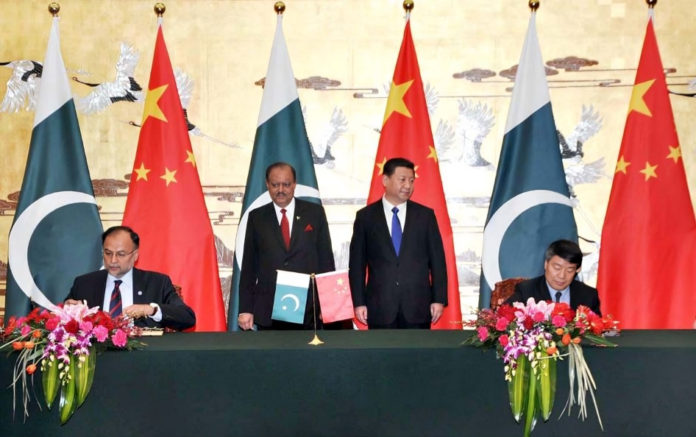
Alfred Mahan and Sir Halford Mackinder were both highly respected geopolitical theorists and contemporaries in the 19th century. While Mahan is better known for his emphasis on maritime power interplay between occidental and oriental global framework, Mackinder is famous for his ‘Heartland Theory’ which stipulated that rule over largest landmass would become the basis for world domination. He later conceded that geopolitical dominance required both a continental and a maritime dimension.
Nearly two centuries later, Mackinder’s and Mahan’s thoughts appear closer to realization as China unfolds its wider global plans to tie up regional loops and nodes with emerging transportation networks into what it calls as ‘One Belt, One Road’ paradigm. The plan is aimed not so much to dominate the world in Mackinder’s sense of the word, rather it is directed towards utilization of China’s massive over capacity, development and industrialization of its less developed western region, and quite significantly, transition of the Chinese economy from its current state of being a ‘world factory’ for manufacturing cheap products for others to an economic powerhouse in its own right, complete with innovative and original products for the benefit of humanity at large.
While the ‘Belt’ reflects the continental component of this initiative, and comprises of networks of railroads, overland highways, oil and gas pipelines and ancillary development projects, stretching from Kashghar to Gwadar in Pakistan, its broader footprint stretches from Xian in Central China, through Central Asia and Russia, with one artery crossing Kazakhstan and the other through Magnolia, both linking up with trans-Siberian railway and reaching out to Moscow, Rotterdam and Venice.
The ‘Road’ on the other hand is the maritime dimension of this paradigm. Like in the case of ‘Belt’, here too the wider footprint of Chinese ambitions reach out to a network of ports and other coastal infrastructure emanating from China’s eastern seaboard and traversing an arc across South East Asia, South Asia, the Gulf, East Africa Mediterranean, and terminating at Piraeus (Greece), Venice (Italy) and Rotterdam (Netherlands) in Europe and Mombasa (Kenya) in Africa.
In the larger Chinese ‘One Belt, One Road’ scheme there are regional loops and branches which extend the reach of emerging transportation networks but also connect them at strategic and critical points across the globe. In the context of China-Pakistan Economic Corridor (CPEC), Gwadar is that strategic and critical point of the project which lies on the intersection of ‘Belt’ and the ‘Road’ and marries up the two components.
CPEC, clearly therefore, is just one segment of that broader Chinese initiative. Apart from the physical dimension of laying down necessary infrastructure in Pakistan’s less developed western region and benefitting local population, the long term and larger objectives of CPEC are enhancing policy co-ordination across the region, trade liberalization, financial integration, and connectivity including that of people to people in the region. Iranian and Russian interest in the project has boosted its significance.
The full execution of this blueprint has a huge potential of meeting the interests of all sides in their socio-economic development and can serve as a strong basis to integrate and develop strategies of the countries along the Belt and the Road. The reason it has attracted global attention from competing forces, especially from our eastern neighbor, is that it is seen as an instrument to create a contagious land and maritime zone where Pakistan, China as well as other regional countries can pursue convergent economic policies moored to robust physical infra-structure and supported by trade and financial flows.

Once completed, CPEC will enhance the socio-economic development of Pakistan in general and of its less developed regions in particular. It has potential of acting as backbone of Pakistan’s economic strength in the global environments of 21st century.
Gwadar port deep water characteristics offer unique opportunities for multi-modal modern global trade which is increasingly putting to use Triple-E class behemoth container ships, manned by just over two dozen highly skilled crew and can carry up to 18,000 containers or more. They are known for their efficiency, economy of scales and environmental friendliness. Pakistan lags far behind in these areas as the present size of vessels calling on Karachi Port Trust and Port Qasim Authority carry about one tenth the numbers of containers transported by Triple-E class ships.
Our on-shore facilities too are sluggish considering that it takes nearly nineteen days for a container to arrive through ship from US east coast to Karachi and it takes nearly the same number of days for it to reach from Karachi to Sialkot Dry Port. The Karachi-Sialkot transit should not take more than three days. This goal is not too ambitious as some Gulf countries in the neighborhood have drastically reduced onshore destination handling time and are plying Triple-E class ships.
Sea trade leading into Gwadar will also require safer navigational environments and that is where the Pakistan Navy will have to play a greater role. Admittedly, incidents of piracy have reduced in recent years but the menace has not been eliminated altogether and can resurface because of instability in the Horn of Africa (HOA) region.
Both China and Pakistan will have to keep an eye on rivalry from mega-economic blocks like the Trans-Pacific Partnership (TTP) in Asia which has been formed only recently and is led by United Sates. As economic resources in this region shrink in the decades ahead, different economic partnerships could pursue their own interest more fiercely and in much more complex ways at a cost to others.
Pakistan has rightly been investing in the Jinnah Naval Base at Ormara located a few miles to the east of Gwadar which the Pakistan Navy can use as pivot to articulate its assets both east and west depending upon the threat. This however may not suffice considering the full scope of CPEC likely to unfold in the next two decades. It would therefore be prudent to dovetail and integrate maritime infrastructure and wherewithal in CPEC plans along other strategic locations on the coast like Gwadar and Jiwani.

For effective and optimal defense of our maritime interest, the overall resource base has to be increased both horizontally and vertically in all three dimensions of naval warfare to meet the emerging security needs at sea by the time CPEC picks up steam and starts to heat up the economy.
Similarly, establishing another naval air base at Turbat for undertaking long range surveillance activities at sea is a prudent step. Pakistan Navy has had its naval aviation arm for nearly forty years which has mainly focused on surveillance with some aircraft armed with air to surface missiles but relied on Pakistan Air Force jet aircraft capability for quick response against rapidly evolving threats at sea.
As the PAF’s own challenge in the skies over Pakistan accentuates manifold, it would make sense to off-load this responsibility and support Pakistan Navy’s quest to have its own fighter jet squadron operating out of Turbat to guard the national maritime interests in the increasingly important western and south western region. With expansion of JF-17 Thunder aircraft manufacturing base at PAF Kamra, this addition in the naval capability in harmony with CPEC’s maritime security should be in the realm of possibility.
It is crucial to understand that CPEC is not only about animated discussions regarding western and eastern routes and putting in place physical infrastructure, albeit this is an indispensable component of the initiative, it also has an important security dimension spanning sea lanes leading up to and out of Gwadar seaport in the south.
While there are plans to put on ground sizeable force for overland security during construction phase which would probably be used later also for the same purpose, it is the seaward security dimension in the over-heated national discourse which has largely remained unmentioned. No gainsaying that the two actually complement each other and each should be structured to reinforce the other.
The project therefore will succeed and flourish only if the maritime trade activities on the routes leading to Gwadar and from Gwadar to other destinations across the globe ply safely and without hindrance from those who have a competing interest in its failure. Pakistan Navy has an onerous national responsibility to ensure the necessary protection and the government has a fundamental obligation to provide essential infrastructure and the means for this purpose.




